MITSUBISHI COLT 2011 Owner's Manual (in English)
Manufacturer: MITSUBISHI, Model Year: 2011, Model line: COLT, Model: MITSUBISHI COLT 2011Pages: 274, PDF Size: 17.88 MB
Page 221 of 274
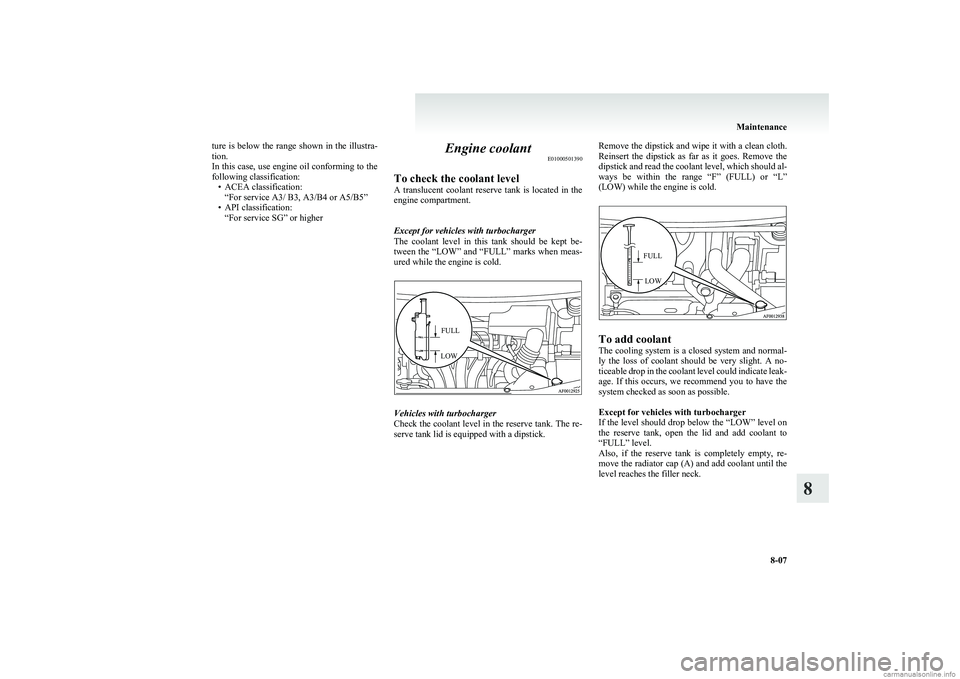
ture is below the range shown in the illustra-
tion.
In this case, use engine oil conforming to the
following classification: • ACEA classification:“For service A3/ B3, A3/B4 or A5/B5”
• API classification: “For service SG” or higherEngine coolant E01000501390
To check the coolant level
A translucent coolant reserve tank is located in the
engine compartment.
Except for vehicles with turbocharger
The coolant level in this tank should be kept be-
tween the “LOW” and “FULL” marks when meas-
ured while the engine is cold.
FULLLOW
Vehicles with turbocharger
Check the coolant level in the reserve tank. The re-
serve tank lid is equipped with a dipstick.
Remove the dipstick and wipe it with a clean cloth.
Reinsert the dipstick as far as it goes. Remove the
dipstick and read the coolant level, which should al-
ways be within the range “F” (FULL) or “L”
(LOW) while the engine is cold.FULLLOW
To add coolant
The cooling system is a closed system and normal-
ly the loss of coolant should be very slight. A no-
ticeable drop in the coolant level could indicate leak-
age. If this occurs, we recommend you to have the
system checked as soon as possible.
Except for vehicles with turbocharger
If the level should drop below the “LOW” level on
the reserve tank, open the lid and add coolant to
“FULL” level.
Also, if the reserve tank is completely empty, re-
move the radiator cap (A) and add coolant until the
level reaches the filler neck.
Maintenance
8-07
8
Page 222 of 274
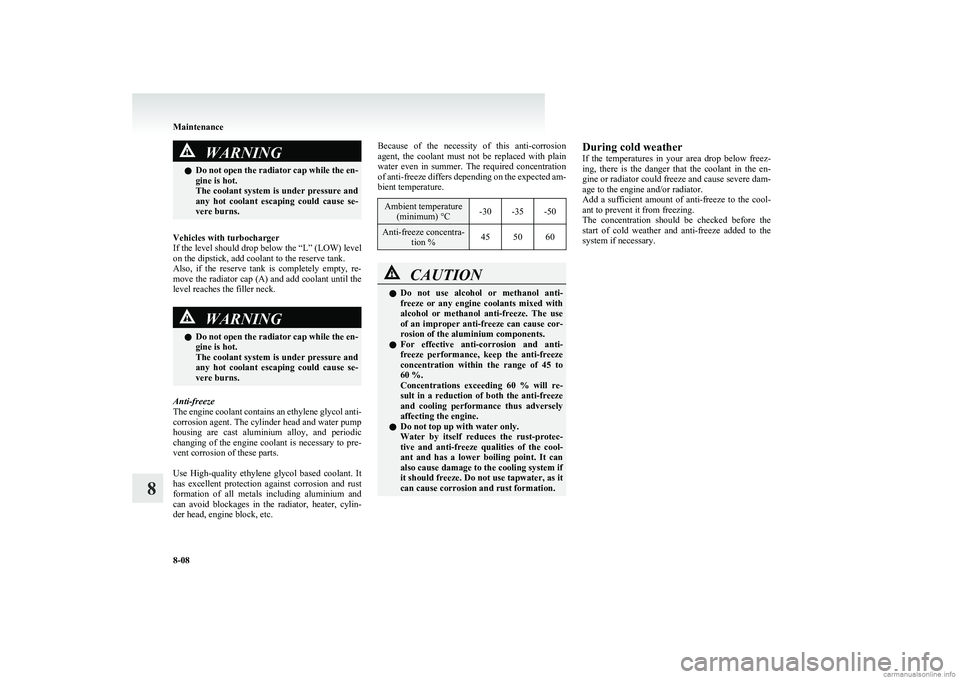
WARNINGlDo not open the radiator cap while the en-
gine is hot.
The coolant system is under pressure and
any hot coolant escaping could cause se-
vere burns.
Vehicles with turbocharger
If the level should drop below the “L” (LOW) level
on the dipstick, add coolant to the reserve tank.
Also, if the reserve tank is completely empty, re-
move the radiator cap (A) and add coolant until the
level reaches the filler neck.
WARNINGl Do not open the radiator cap while the en-
gine is hot.
The coolant system is under pressure and
any hot coolant escaping could cause se-
vere burns.
Anti-freeze
The engine coolant contains an ethylene glycol anti-
corrosion agent. The cylinder head and water pump
housing are cast aluminium alloy, and periodic
changing of the engine coolant is necessary to pre-
vent corrosion of these parts.
Use High-quality ethylene glycol based coolant. It
has excellent protection against corrosion and rust
formation of all metals including aluminium and
can avoid blockages in the radiator, heater, cylin-
der head, engine block, etc.
Because of the necessity of this anti-corrosion
agent, the coolant must not be replaced with plain
water even in summer. The required concentration
of anti-freeze differs depending on the expected am-
bient temperature.Ambient temperature (minimum) °C-30-35-50Anti-freeze concentra- tion %455060CAUTIONlDo not use alcohol or methanol anti-
freeze or any engine coolants mixed with
alcohol or methanol anti-freeze. The use
of an improper anti-freeze can cause cor-
rosion of the aluminium components.
l For effective anti-corrosion and anti-
freeze performance, keep the anti-freeze
concentration within the range of 45 to
60 %.
Concentrations exceeding 60 % will re-
sult in a reduction of both the anti-freeze
and cooling performance thus adversely
affecting the engine.
l Do not top up with water only.
Water by itself reduces the rust-protec-
tive and anti-freeze qualities of the cool-
ant and has a lower boiling point. It can
also cause damage to the cooling system if
it should freeze. Do not use tapwater, as it
can cause corrosion and rust formation.During cold weather
If the temperatures in your area drop below freez-
ing, there is the danger that the coolant in the en-
gine or radiator could freeze and cause severe dam-
age to the engine and/or radiator.
Add a sufficient amount of anti-freeze to the cool-
ant to prevent it from freezing.
The concentration should be checked before the
start of cold weather and anti-freeze added to the
system if necessary.
Maintenance
8-08
8
Page 223 of 274
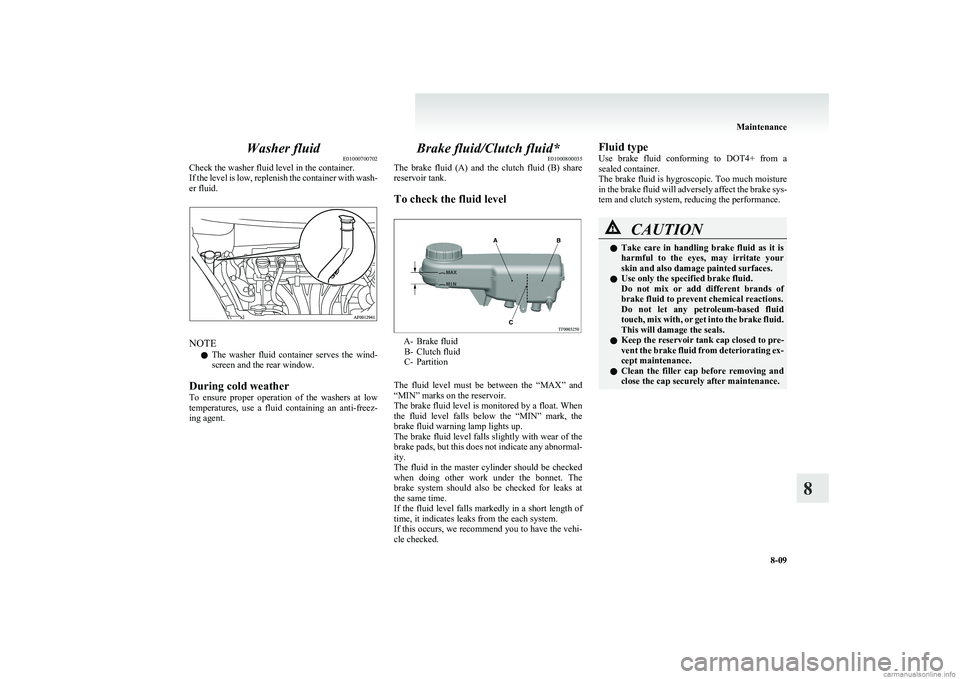
Washer fluidE01000700702
Check the washer fluid level in the container.
If the level is low, replenish the container with wash-
er fluid.
NOTE
l The washer fluid container serves the wind-
screen and the rear window.
During cold weather
To ensure proper operation of the washers at low
temperatures, use a fluid containing an anti-freez-
ing agent.
Brake fluid/Clutch fluid* E01000800035
The brake fluid (A) and the clutch fluid (B) share
reservoir tank.
To check the fluid level
A- Brake fluid B- Clutch fluid
C- Partition
The fluid level must be between the “MAX” and
“MIN” marks on the reservoir.
The brake fluid level is monitored by a float. When
the fluid level falls below the “MIN” mark, the
brake fluid warning lamp lights up.
The brake fluid level falls slightly with wear of the
brake pads, but this does not indicate any abnormal-
ity.
The fluid in the master cylinder should be checked
when doing other work under the bonnet. The
brake system should also be checked for leaks at
the same time.
If the fluid level falls markedly in a short length of
time, it indicates leaks from the each system.
If this occurs, we recommend you to have the vehi-
cle checked.
Fluid type
Use brake fluid conforming to DOT4+ from a
sealed container.
The brake fluid is hygroscopic. Too much moisture
in the brake fluid will adversely affect the brake sys-
tem and clutch system, reducing the performance.CAUTIONl Take care in handling brake fluid as it is
harmful to the eyes, may irritate your
skin and also damage painted surfaces.
l Use only the specified brake fluid.
Do not mix or add different brands of
brake fluid to prevent chemical reactions.
Do not let any petroleum-based fluid
touch, mix with, or get into the brake fluid.
This will damage the seals.
l Keep the reservoir tank cap closed to pre-
vent the brake fluid from deteriorating ex-
cept maintenance.
l Clean the filler cap before removing and
close the cap securely after maintenance.
Maintenance
8-09
8
Page 224 of 274
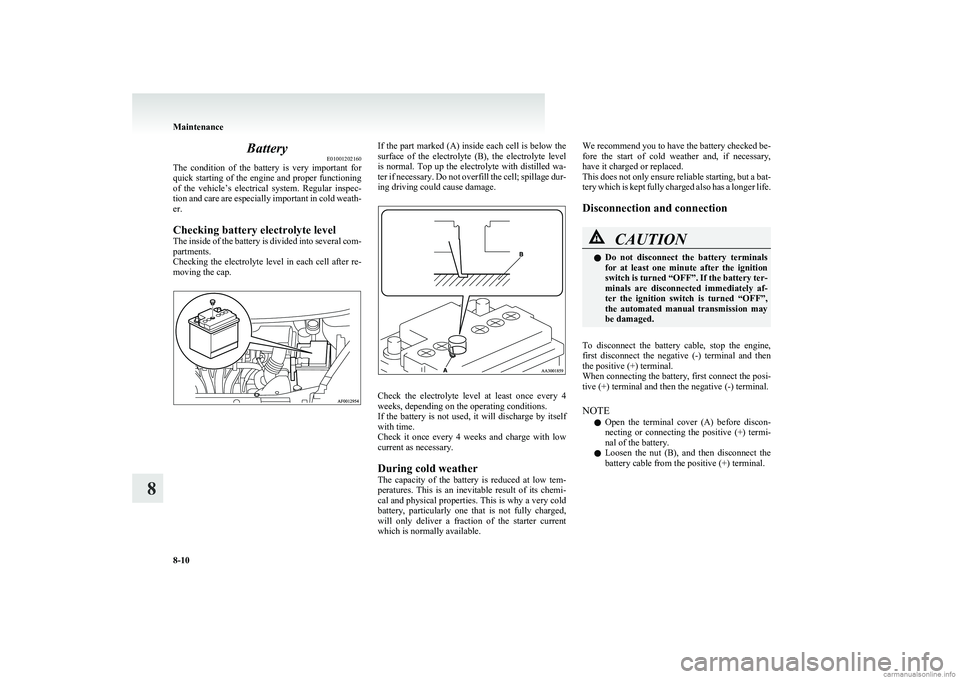
BatteryE01001202160
The condition of the battery is very important for
quick starting of the engine and proper functioning
of the vehicle’s electrical system. Regular inspec-
tion and care are especially important in cold weath-
er.
Checking battery electrolyte level
The inside of the battery is divided into several com-
partments.
Checking the electrolyte level in each cell after re-
moving the cap.If the part marked (A) inside each cell is below the
surface of the electrolyte (B), the electrolyte level
is normal. Top up the electrolyte with distilled wa-
ter if necessary. Do not overfill the cell; spillage dur-
ing driving could cause damage.
Check the electrolyte level at least once every 4
weeks, depending on the operating conditions.
If the battery is not used, it will discharge by itself
with time.
Check it once every 4 weeks and charge with low
current as necessary.
During cold weather
The capacity of the battery is reduced at low tem-
peratures. This is an inevitable result of its chemi-
cal and physical properties. This is why a very cold
battery, particularly one that is not fully charged,
will only deliver a fraction of the starter current
which is normally available.
We recommend you to have the battery checked be-
fore the start of cold weather and, if necessary,
have it charged or replaced.
This does not only ensure reliable starting, but a bat-
tery which is kept fully charged also has a longer life.
Disconnection and connectionCAUTIONl Do not disconnect the battery terminals
for at least one minute after the ignition
switch is turned “OFF”. If the battery ter-
minals are disconnected immediately af-
ter the ignition switch is turned “OFF”,
the automated manual transmission may
be damaged.
To disconnect the battery cable, stop the engine,
first disconnect the negative (-) terminal and then
the positive (+) terminal.
When connecting the battery, first connect the posi-
tive (+) terminal and then the negative (-) terminal.
NOTE l Open the terminal cover (A) before discon-
necting or connecting the positive (+) termi-
nal of the battery.
l Loosen the nut (B), and then disconnect the
battery cable from the positive (+) terminal.
Maintenance
8-10
8
Page 225 of 274
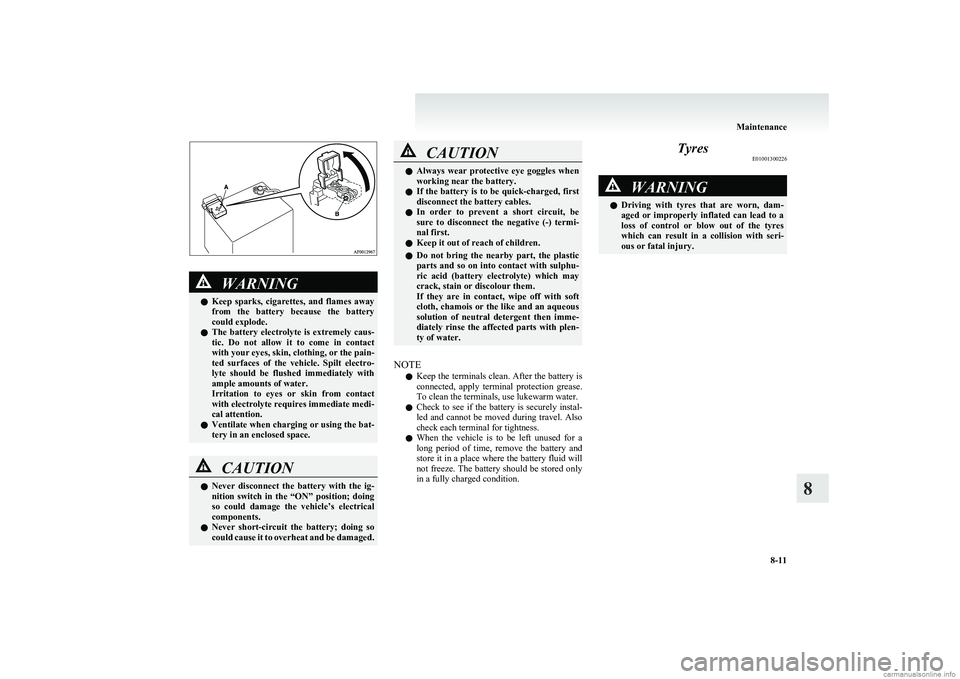
WARNINGlKeep sparks, cigarettes, and flames away
from the battery because the battery
could explode.
l The battery electrolyte is extremely caus-
tic. Do not allow it to come in contact
with your eyes, skin, clothing, or the pain-
ted surfaces of the vehicle. Spilt electro-
lyte should be flushed immediately with
ample amounts of water.
Irritation to eyes or skin from contact
with electrolyte requires immediate medi-
cal attention.
l Ventilate when charging or using the bat-
tery in an enclosed space.CAUTIONl Never disconnect the battery with the ig-
nition switch in the “ON” position; doing
so could damage the vehicle’s electrical
components.
l Never short-circuit the battery; doing so
could cause it to overheat and be damaged.CAUTIONl Always wear protective eye goggles when
working near the battery.
l If the battery is to be quick-charged, first
disconnect the battery cables.
l In order to prevent a short circuit, be
sure to disconnect the negative (-) termi-
nal first.
l Keep it out of reach of children.
l Do not bring the nearby part, the plastic
parts and so on into contact with sulphu-
ric acid (battery electrolyte) which may
crack, stain or discolour them.
If they are in contact, wipe off with soft
cloth, chamois or the like and an aqueous
solution of neutral detergent then imme-
diately rinse the affected parts with plen-
ty of water.
NOTE
l Keep the terminals clean. After the battery is
connected, apply terminal protection grease.
To clean the terminals, use lukewarm water.
l Check to see if the battery is securely instal-
led and cannot be moved during travel. Also
check each terminal for tightness.
l When the vehicle is to be left unused for a
long period of time, remove the battery and
store it in a place where the battery fluid will
not freeze. The battery should be stored only
in a fully charged condition.
Tyres E01001300226WARNINGlDriving with tyres that are worn, dam-
aged or improperly inflated can lead to a
loss of control or blow out of the tyres
which can result in a collision with seri-
ous or fatal injury.
Maintenance
8-11
8
Page 226 of 274
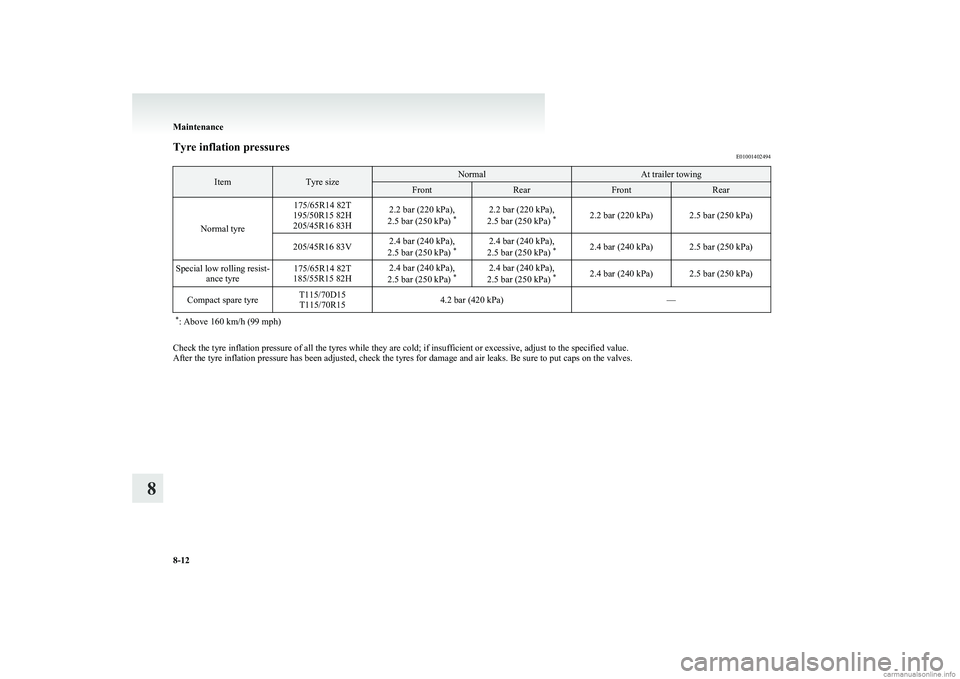
Tyre inflation pressuresE01001402494ItemTyre sizeNormalAt trailer towingFrontRearFrontRear
Normal tyre
175/65R14 82T
195/50R15 82H
205/45R16 83H2.2 bar (220 kPa),
2.5 bar (250 kPa) *2.2 bar (220 kPa),
2.5 bar (250 kPa) *2.2 bar (220 kPa)2.5 bar (250 kPa)205/45R16 83V2.4 bar (240 kPa),
2.5 bar (250 kPa) *2.4 bar (240 kPa),
2.5 bar (250 kPa) *2.4 bar (240 kPa)2.5 bar (250 kPa)Special low rolling resist-
ance tyre175/65R14 82T
185/55R15 82H2.4 bar (240 kPa),
2.5 bar (250 kPa) *2.4 bar (240 kPa),
2.5 bar (250 kPa) *2.4 bar (240 kPa)2.5 bar (250 kPa)Compact spare tyreT115/70D15
T115/70R154.2 bar (420 kPa)—* : Above 160 km/h (99 mph)
Check the tyre inflation pressure of all the tyres while they are cold; if insufficient or excessive, adjust to the specified value.
After the tyre inflation pressure has been adjusted, check the tyres for damage and air leaks. Be sure to put caps on the valves.
Maintenance
8-12
8
Page 227 of 274
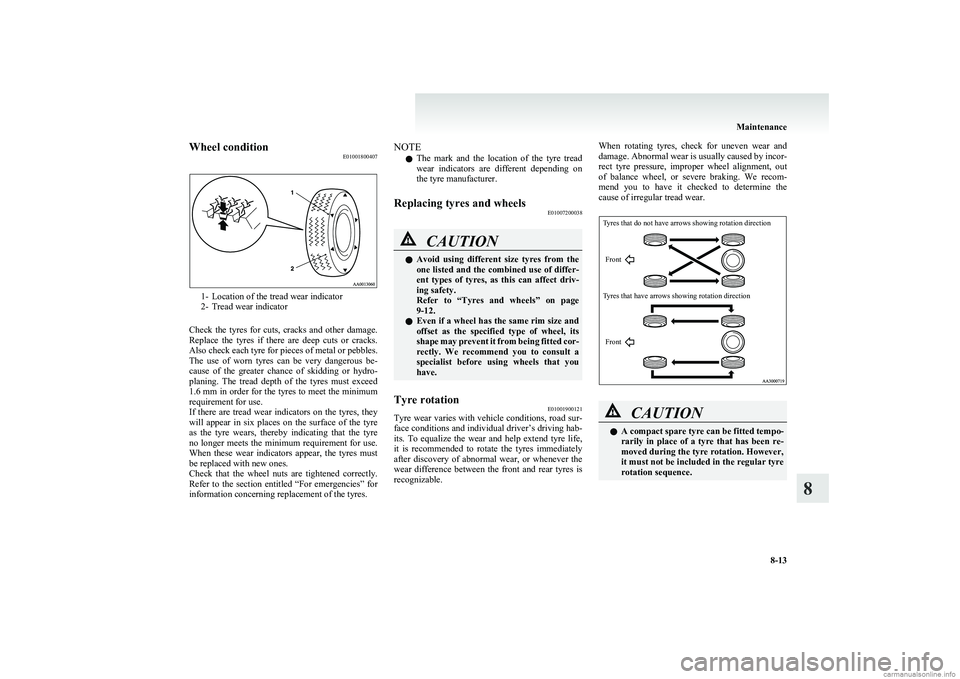
Wheel conditionE01001800407
1- Location of the tread wear indicator
2- Tread wear indicator
Check the tyres for cuts, cracks and other damage.
Replace the tyres if there are deep cuts or cracks.
Also check each tyre for pieces of metal or pebbles.
The use of worn tyres can be very dangerous be-
cause of the greater chance of skidding or hydro-
planing. The tread depth of the tyres must exceed
1.6 mm in order for the tyres to meet the minimum
requirement for use.
If there are tread wear indicators on the tyres, they
will appear in six places on the surface of the tyre
as the tyre wears, thereby indicating that the tyre
no longer meets the minimum requirement for use.
When these wear indicators appear, the tyres must
be replaced with new ones.
Check that the wheel nuts are tightened correctly.
Refer to the section entitled “For emergencies” for
information concerning replacement of the tyres.
NOTE
l The mark and the location of the tyre tread
wear indicators are different depending on
the tyre manufacturer.Replacing tyres and wheels E01007200038CAUTIONlAvoid using different size tyres from the
one listed and the combined use of differ-
ent types of tyres, as this can affect driv-
ing safety.
Refer to “Tyres and wheels” on page
9-12.
l Even if a wheel has the same rim size and
offset as the specified type of wheel, its
shape may prevent it from being fitted cor-
rectly. We recommend you to consult a
specialist before using wheels that you
have.Tyre rotation E01001900121
Tyre wear varies with vehicle conditions, road sur-
face conditions and individual driver’s driving hab-
its. To equalize the wear and help extend tyre life,
it is recommended to rotate the tyres immediately
after discovery of abnormal wear, or whenever the
wear difference between the front and rear tyres is
recognizable.
When rotating tyres, check for uneven wear and
damage. Abnormal wear is usually caused by incor-
rect tyre pressure, improper wheel alignment, out
of balance wheel, or severe braking. We recom-
mend you to have it checked to determine the
cause of irregular tread wear.Tyres that do not have arrows showing rotation directionTyres that have arrows showing rotation directionFrontFront
CAUTIONl A compact spare tyre can be fitted tempo-
rarily in place of a tyre that has been re-
moved during the tyre rotation. However,
it must not be included in the regular tyre
rotation sequence.
Maintenance
8-13
8
Page 228 of 274
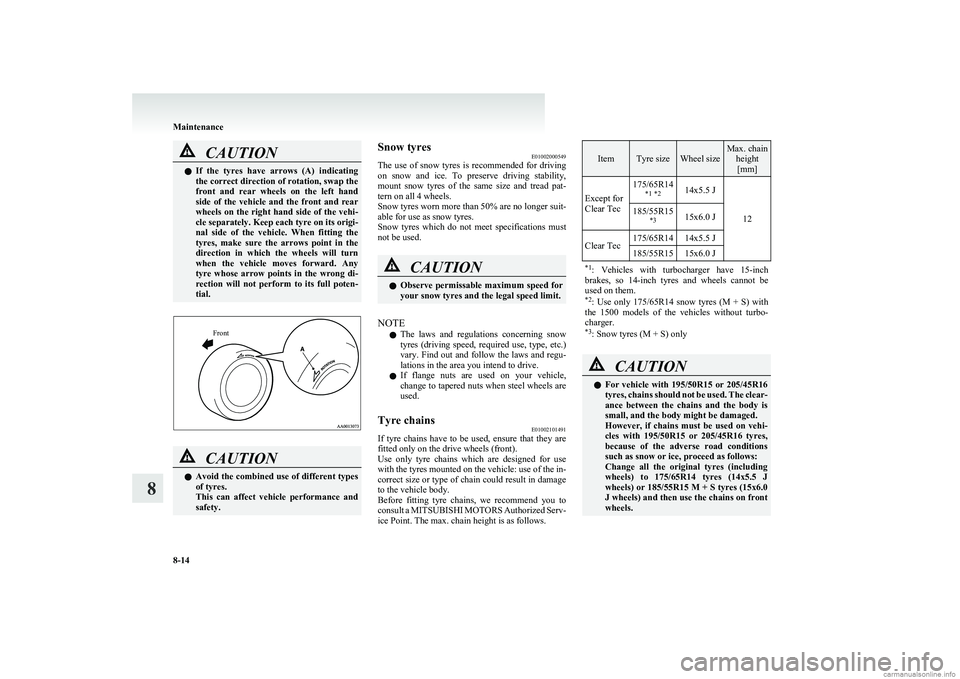
CAUTIONlIf the tyres have arrows (A) indicating
the correct direction of rotation, swap the
front and rear wheels on the left hand
side of the vehicle and the front and rear
wheels on the right hand side of the vehi-
cle separately. Keep each tyre on its origi-
nal side of the vehicle. When fitting the
tyres, make sure the arrows point in the
direction in which the wheels will turn
when the vehicle moves forward. Any
tyre whose arrow points in the wrong di-
rection will not perform to its full poten-
tial.Front
CAUTIONl Avoid the combined use of different types
of tyres.
This can affect vehicle performance and
safety.Snow tyres E01002000549
The use of snow tyres is recommended for driving
on snow and ice. To preserve driving stability,
mount snow tyres of the same size and tread pat-
tern on all 4 wheels.
Snow tyres worn more than 50% are no longer suit-
able for use as snow tyres.
Snow tyres which do not meet specifications must
not be used.CAUTIONl Observe permissable maximum speed for
your snow tyres and the legal speed limit.
NOTE
l The laws and regulations concerning snow
tyres (driving speed, required use, type, etc.)
vary. Find out and follow the laws and regu-
lations in the area you intend to drive.
l If flange nuts are used on your vehicle,
change to tapered nuts when steel wheels are
used.
Tyre chains E01002101491
If tyre chains have to be used, ensure that they are
fitted only on the drive wheels (front).
Use only tyre chains which are designed for use
with the tyres mounted on the vehicle: use of the in-
correct size or type of chain could result in damage
to the vehicle body.
Before fitting tyre chains, we recommend you to
consult a MITSUBISHI MOTORS Authorized Serv-
ice Point. The max. chain height is as follows.
ItemTyre sizeWheel sizeMax. chain height[mm]
Except for
Clear Tec
175/65R14 *1 *214x5.5 J
12
185/55R15
*315x6.0 JClear Tec175/65R1414x5.5 J185/55R1515x6.0 J*1: Vehicles with turbocharger have 15-inch
brakes, so 14-inch tyres and wheels cannot be
used on them.
*2 : Use only 175/65R14 snow tyres (M + S) with
the 1500 models of the vehicles without turbo-
charger.
*3 : Snow tyres (M + S) onlyCAUTIONl For vehicle with 195/50R15 or 205/45R16
tyres, chains should not be used. The clear-
ance between the chains and the body is
small, and the body might be damaged.
However, if chains must be used on vehi-
cles with 195/50R15 or 205/45R16 tyres,
because of the adverse road conditions
such as snow or ice, proceed as follows:
Change all the original tyres (including
wheels) to 175/65R14 tyres (14x5.5 J
wheels) or 185/55R15 M + S tyres (15x6.0
J wheels) and then use the chains on front
wheels.
Maintenance
8-14
8
Page 229 of 274
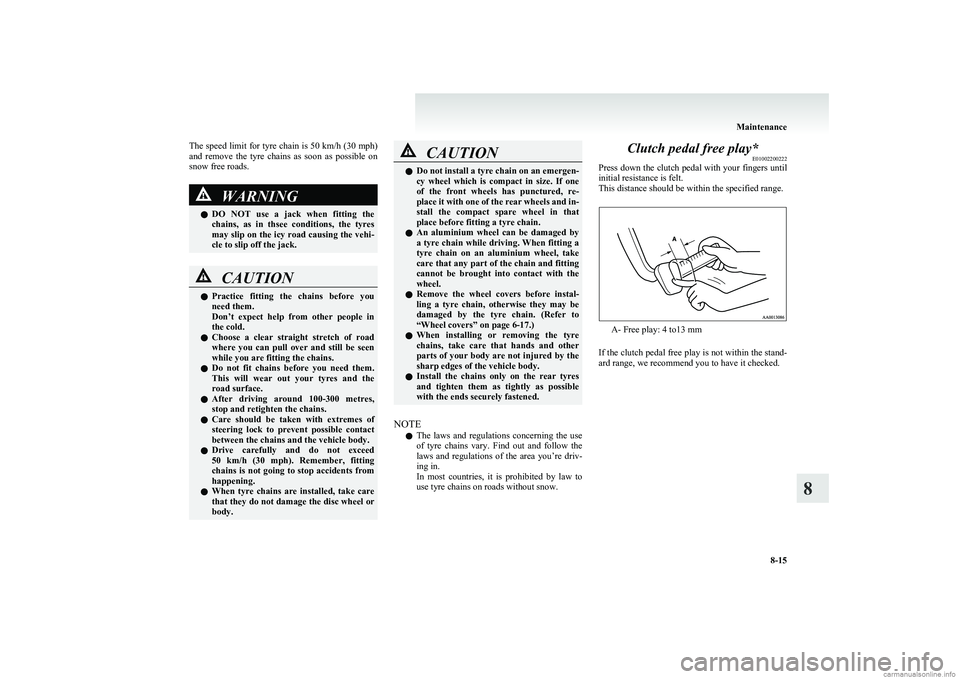
The speed limit for tyre chain is 50 km/h (30 mph)
and remove the tyre chains as soon as possible on
snow free roads.WARNINGl DO NOT use a jack when fitting the
chains, as in thsee conditions, the tyres
may slip on the icy road causing the vehi-
cle to slip off the jack.CAUTIONl Practice fitting the chains before you
need them.
Don’t expect help from other people in
the cold.
l Choose a clear straight stretch of road
where you can pull over and still be seen
while you are fitting the chains.
l Do not fit chains before you need them.
This will wear out your tyres and the
road surface.
l After driving around 100-300 metres
,
stop and retighten the chains.
l Care should be taken with extremes of
steering lock to prevent possible contact
between the chains and the vehicle body.
l Drive carefully and do not exceed
50 km/h (30 mph). Remember, fitting
chains is not going to stop accidents from
happening.
l When tyre chains are installed, take care
that they do not damage the disc wheel or
body.CAUTIONl Do not install a tyre chain on an emergen-
cy wheel which is compact in size. If one
of the front wheels has punctured, re-
place it with one of the rear wheels and in-
stall the compact spare wheel in that
place before fitting a tyre chain.
l An aluminium wheel can be damaged by
a tyre chain while driving. When fitting a
tyre chain on an aluminium wheel, take
care that any part of the chain and fitting
cannot be brought into contact with the
wheel.
l Remove the wheel covers before instal-
ling a tyre chain, otherwise they may be
damaged by the tyre chain. (Refer to
“Wheel covers” on page 6-17.)
l When installing or removing the tyre
chains, take care that hands and other
parts of your body are not injured by the
sharp edges of the vehicle body.
l Install the chains only on the rear tyres
and tighten them as tightly as possible
with the ends securely fastened.
NOTE
l The laws and regulations concerning the use
of tyre chains vary. Find out and follow the
laws and regulations of the area you’re driv-
ing in.
In most countries, it is prohibited by law to
use tyre chains on roads without snow.
Clutch pedal free play* E01002200222
Press down the clutch pedal with your fingers until
initial resistance is felt.
This distance should be within the specified range.
A- Free play: 4 to13 mm
If the clutch pedal free play is not within the stand-
ard range, we recommend you to have it checked.
Maintenance
8-15
8
Page 230 of 274
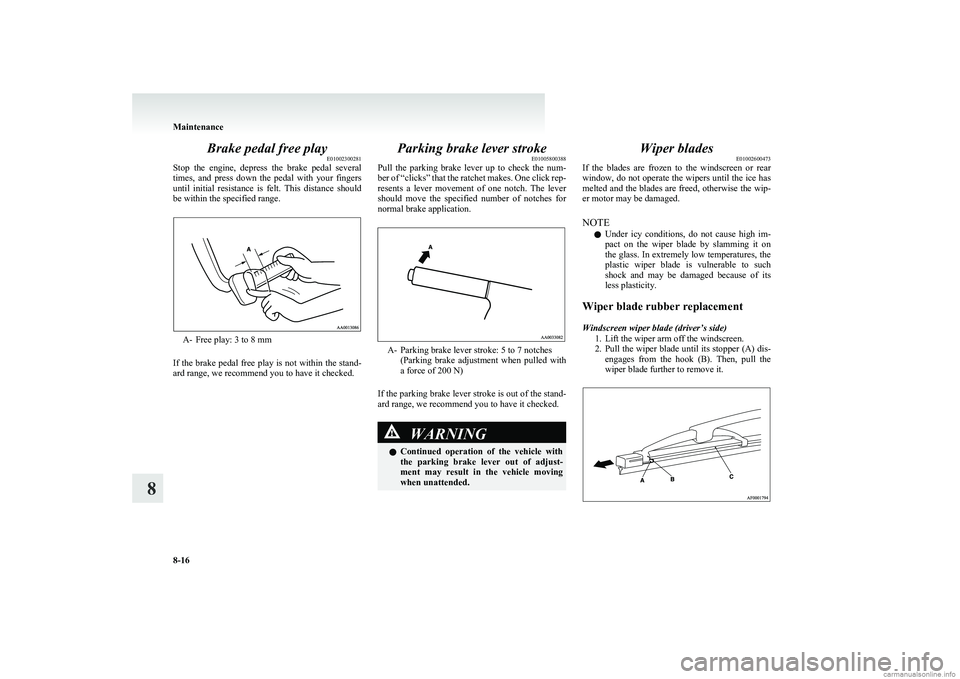
Brake pedal free playE01002300281
Stop the engine, depress the brake pedal several
times, and press down the pedal with your fingers
until initial resistance is felt. This distance should
be within the specified range.
A- Free play: 3 to 8 mm
If the brake pedal free play is not within the stand-
ard range, we recommend you to have it checked.
Parking brake lever stroke E01005800388
Pull the parking brake lever up to check the num-
ber of “clicks” that the ratchet makes. One click rep-
resents a lever movement of one notch. The lever
should move the specified number of notches for
normal brake application.
A- Parking brake lever stroke: 5 to 7 notches (Parking brake adjustment when pulled with
a force of 200 N)
If the parking brake lever stroke is out of the stand-
ard range, we recommend you to have it checked.
WARNINGl Continued operation of the vehicle with
the parking brake lever out of adjust-
ment may result in the vehicle moving
when unattended.Wiper blades E01002600473
If the blades are frozen to the windscreen or rear
window, do not operate the wipers until the ice has
melted and the blades are freed, otherwise the wip-
er motor may be damaged.
NOTE l Under icy conditions, do not cause high im-
pact on the wiper blade by slamming it on
the glass. In extremely low temperatures, the
plastic wiper blade is vulnerable to such
shock and may be damaged because of its
less plasticity.
Wiper blade rubber replacement
Windscreen wiper blade (driver’s side) 1. Lift the wiper arm off the windscreen.
2. Pull the wiper blade until its stopper (A) dis-
engages from the hook (B). Then, pull the
wiper blade further to remove it.
Maintenance
8-16
8